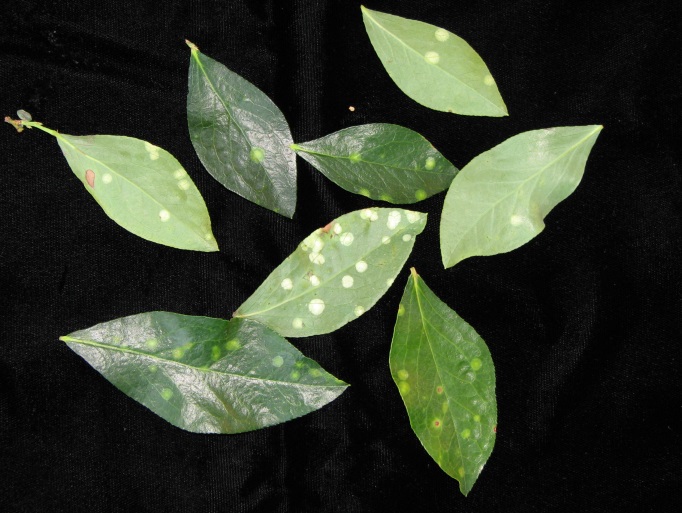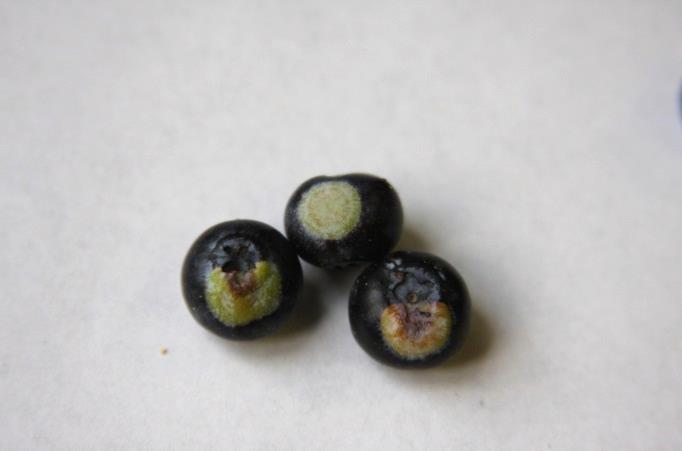Exobasidium leaf and fruit spot has been an infrequent and geographically dispersed disease of blueberries in the Southeast. However, during the 2011-2013 harvest seasons, we have had frequent reports of the disease in rabbiteye and highbush blueberries. Although scattered, where Exobasidium leaf and fruit spot occurs it can cause significant losses (60-70% in specific locations), primarily because affected fruit are unmarketable and it is difficult to remove all berries with this symptom from the packing line; in addition, fruit drop occurs with some varieties.
The fruit stage of this disease was first reported in 1997 in North Carolina. In recent years, symptoms on rabbiteye blueberries in Mississippi have been so severe and recurrent as to cause fields to be abandoned. Although the fruit spots do not rot or become necrotic, they do not ripen well and remain firm and green. Exobasidium-affected berries can be eaten, but they are extremely chewy where the spot occurs – not a great culinary experience.
Symptoms. The first visible symptoms of the disease are light green leaf spots (approximately ¼ inch in diameter) that form on the upper side of infected leaves in the spring. Leaf spots are often pure white on the leaf underside due to a thin, dense layer of fungal growth. Furthermore, the affected leaf area is slightly thicker than surrounding tissue, and becomes necrotic with age during the summer. Spots on fruit, first apparent when fruit turn color, average ¼ inch in diameter, and are circular and generally regular in appearance. They do not protrude, but may be sunken and are sometimes tinged with a red color. The diseased fruit tissue is green and unripe, extending roughly 1/8 inch toward the berry center. The spots on berries can occasionally show sparse white fungal growth.
Causal organism. The cause of Exobasidium leaf and fruit spot has been classified recently as the fungus Exobasidium maculosum by Dr. Marin Brewer at the University of Georgia. County Extension offices can diagnose this disease, either directly through in-office examination or through shipment to diagnostic clinics. Microscopic observation of the spores can be used to confirm the diagnosis. The pathogen produces two types of spores, sexual basidiospores and asexual conidia.
Disease cycle. At this point, the epidemiology and life cycle of the disease have not been clarified. It is assumed that the disease has a one-year cycle (i.e., is not systemic within the plant), and that the pathogen overwinters on or in infected bud scales and/or on or in the bark. Infection occurs in the spring, and late-season leaf flushes do not show additional spots. With the related fungus Exobasidium vaccinii that causes leaf galls on azalea in the Southeast, the spores produced from leaves blow or wash to flower or leaf buds to infect anew, but symptoms do not occur until the following spring. The blueberry Exobasium cycle may be similar, but this needs to be researched in detail.
Cultural controls. (1) Select sites which encourage air flow and low humidity. The disease is generally more prevalent in plantings which are either surrounded by trees (reduced air flow) and/or next to areas of high humidity (i.e., ponds or low spots where water stands). It is likely that poor air flow, slow drying conditions, and high humidity contribute to an increase in disease severity.
(2) Use proper pruning and cane renewal to open up the canopy and allow for better fungicide penetration and air movement (drying). It has been observed that symptoms are most severe in the bush interior. This likely relates to poor air movement, high humidity, and possibly poor spray penetration.
(3) Disease resistance is likely present in some varieties, but no surveys or controlled experiments have been conducted to determine which varieties show resistance. In 2013, ‘Premier’ was highly susceptible, but other varieties such as ‘Tifblue’, ‘Star’, and ‘Powderblue’ were diseased as well. Limited or no infection was observed on ‘Climax’.
Chemical controls. In general, where plants receive an effective early-season fungicide program, we have not observed the disease at significant levels. In our research trials, a single late-dormant application of lime sulfur provided substantial and statistically equivalent management of Exobasidium to that afforded by multiple applications of either Captan or Indar applied at a typical mummy berry schedule (Table 1). The high level of disease suppression with late-dormant lime sulfur may indicate that overwintering inoculum and/or early-season infections are of primary importance to disease development. For in-season applications (between green tip and early cover sprays), the efficacy ranking was Captan>Indar>Pristine, with Pristine performing relatively poorly when applied only in the cover sprays. All three of these fungicides performed better when applied during the early or full block regimens (Table 1), again supporting the premise that infections are occurring early in the development of leaves and fruit. No plant injury was observed with any tested fungicide.
Lime sulfur does not currently have Exobasium on the label, but it is labeled for other blueberry diseases such as Phomopsis twig blight, and producers can legally apply lime sulfur for these other diseases. Apply lime sulfur at bud swell, about 2 weeks before first green tissue or flowers are exposed.
It is likely that we will have numerous questions relative the use of lime sulfur as we move into next year. Lime sulfur is a caustic and dangerous material, so producers need to read the label carefully and follow all PPE recommendations. Liquid lime sulfur has “Danger” (not “Warning” or “Caution”) on the label. It will burn the eyes and skin. It should not be applied within 14 days of an oil spray or at high temperatures, as phytotoxicity (plant injury) can occur.
Sulforix is a fungicide that is chemically very similar to lime sulfur, and it is sold by the same distributor. Although Sulforix may provide similar disease control, we do not have research data in Georgia to support that premise at this time. Either product can burn exposed green tissue. Sulforix will likely be more readily available than liquid lime sulfur in the marketplace. However, an August 2013 discussion of Sulforix versus lime sulfur by numerous small fruit experts from throughout the nation revealed that none felt they had enough research-based information to support the claims that Sulforix would be equivalent to lime sulfur. We hope to work on that question in 2014.
There is an anecdotal correlation between poor fungicide programs for mummy berry and an increase in Exobasidium leaf and fruit spot over time. Where the disease has been a problem, the following program is recommended as a means of suppressing Exobasidium while managing other blueberry diseases: (1) apply lime sulfur at late dormant (about 1-2 weeks prior to bud break) for Phomopsis suppression, (2) apply Indar + Captan from green tip through petal fall for mummy berry management, and (3) apply Captan for at least two cover sprays for fruit rot control. This program includes the most efficacious fungicides for which we have supporting data to date.
We will continue to expand our knowledge of Exobasidium biology and control recommendations over the next few years. However, we are hopeful that the above information will help manage the disease as we continue our research.
References.
Cline, W.O. 1998. An Exobasidium disease of fruit and leaves of highbush blueberry. Plant Disease 82(9):1064.
Caruso, F.L., and Ramsdell, D.C. eds. 1995. Compendium of Blueberry and Cranberry Diseases. American Phytopathological Society, St. Paul, MN.
Sinclair, W.A., and Lyon, H.H. 2005. Diseases of Trees and Shrubs, 2nd Ed. Cornell Univ. Press, Ithaca, NY.
Table 1. Influence of fungicides on incidence and severity of Exobasidium fruit and leaf spot at a test site in Bacon County, 2013 (‘Premier’).
| Treatment and rate/A |
Application timingz |
Leaf spot incidence (%)y |
Leaf spot severity (spots/leaf)y |
Fruit spot incidence (%)x |
|
| 1. | Untreated control…….. |
—- |
48.0 a | 2.9 a | 32.4 a |
| 2. | Lime Sulfur 5 gal…….. |
1 |
5.7 cd | 0.1 c | 2.8 de |
| 3. | Captan 4L 2.5 qt…….. |
2-6 |
8.3 cd | 0.2 c | 4.4 cde |
| 4. | Indar 2F 6fl oz………… |
2-6 |
23.1 b | 0.5 c | 12.3 bc |
| 5. | Pristine 22 oz…………… |
2-6 |
24.0 b | 0.5 c | 10.3 bcd |
| 6. | Captan 4L 2.5 qt…….. |
7-9 |
6.7 cd | 0.1 c | 12.2 bc |
| 7. | Indar 2F 6fl oz………… |
7-9 |
15.5 bc | 0.3 c | 16.6 b |
| 8. | Pristine 22 oz…………… |
7-9 |
39.2 a | 1.8 b | 31.0 a |
| 9. | Captan 4L 2.5 qt…….. |
2-9 |
1.3 d | 0.0 c | 1.0 e |
| 10. | Indar 2F 6fl oz………… |
2-9 |
4.4 cd | 0.1 c | 4.0 cde |
| 11. | Pristine 22 oz…………… |
2-9 |
25.0 b | 0.7 c | 14.4 b |
zTreatment dates and corresponding plant phenologies: 1 = 5 Feb (late dormant); 2 = 14 Feb (early green tip); 3 = 28 Feb (green tip, 4% bloom); 4 = 14 Mar (32% bloom); 5 = 21 Mar (58% bloom); 6 = 28 Mar (84% bloom); 7 = 1 Apr (petal fall); 8 = 12 Apr (first cover); 9 = 19 Apr (second cover).
yRecorded for 20 shoots per plot with ~7 leaves per shoot on average. Means followed by the same letter are not significantly different when using Tukey’s test (P = 0.05).
xRecorded for ~300 fruit per plot on average. Means followed by the same letter are not significantly different when using Tukey’s test (P = 0.05).

